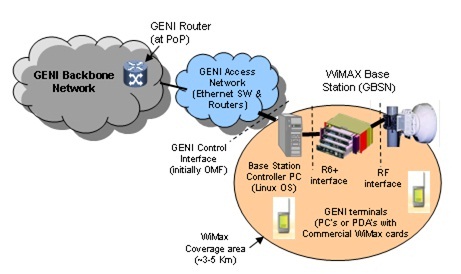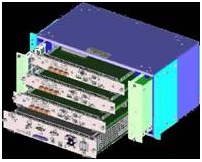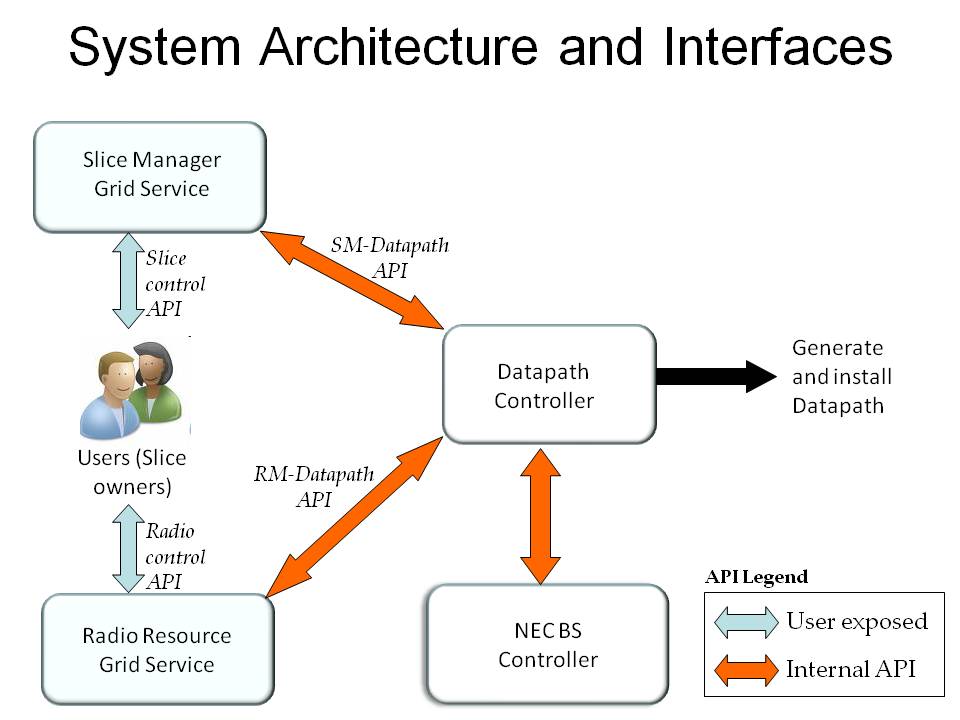| Version 21 (modified by , 12 years ago) ( diff ) |
|---|
WiMAX
Table of Contents
- WiMAX
- WiMAX Virtual Machine Grid Service
- Licensed WiMAX Deployments
- NEC Basestation Controller
- API Classification and Usage
- Accessing the WiMAX Base Station
- Slice Manager API Specification (User Exposed)
- Radio Management API (User Exposed)
- System Administrator API Specification (Internal)
- SM – Datapath API (Internal)
- RM – Datapath API (Internal)
- BSFB – Datapath API (Internal)
Test include to wimax wiki
Login into reserved domain
Login into reserved domain
During your approved time slot, you will be able to ssh into the console of the respective domain. A console is a dedicated machine that allows access to all resources in that domain.
For example, to access the sandbox1:
yourhost>ssh username@console.sb1.orbit-lab.org Using username "username". Authenticating with public key "xxxxxxxxx" Welcome to Ubuntu 12.04.1 LTS (GNU/Linux 3.2.0-36-generic x86_64) * Documentation: https://help.ubuntu.com/ System information as of Mon Jan 28 20:25:50 EST 2013 System load: 0.0 Processes: 93 Usage of /: 2.7% of 69.43GB Users logged in: 0 Memory usage: 6% IP address for eth0: 10.50.18.10 Swap usage: 0% IP address for eth1: 10.18.0.10 Graph this data and manage this system at https://landscape.canonical.com/ 9 packages can be updated. 0 updates are security updates. |-----------------------------------------------------------------| | *** For authorized use only *** | | This system is for the use of authorized users only. All users | | are expected to comply with the "Acceptable Use Policy" availa- | | ble at http://www.orbit-lab.org/AUP.html | | Individuals using this computer system, are subject to having | | all of their activities on this system monitored and recorded | | by system personnel. | | | | Anyone using this system expressly consents to such monitoring | | and is advised that if such monitoring reveals possible | | evidence of criminal activity, system personnel may provide the | | evidence of such monitoring to law enforcement officials. | | | | Email question, comments or problems to help@orbit-lab.org | |-----------------------------------------------------------------| username@console.sb1:~$
Integration of the WiMAX Basestation with GENI
The figure above shows a schematic representation of the WiMAX base station router and its connection to the rest of the network. As shown, the WiMAX base station is typically connected to a GENI access network with layer 2 switched connectivity using Ethernet or optical fiber technology. The figure also indicates three distinct interfaces associated with the GENI WiMAX base station. The first is the GENI control interface for experimenter access to virtual networks (slices) supported by the external base station controller. This is the primary interface relevant to a GENI experimenter, and is currently based on the ORBIT Management Framework (OMF). The second interface is the so-called R6+ interface by which the base station controller communicates with the base station hardware (which includes its own internal controller running a proprietary NEC operating system and control/management software). The R6+ interface exposes the hardware features such as assignment of MAC/PHY resources (i.e. OFDMA time-frequency slots, power levels, service classification, etc.) to each flow, as well as management interfaces for initial configuration, scheduler policy selection and queue management.
Useful Links:
(1) BTS setup with the ORBIT framework
NEC WiMAX Basestation Hardware
The NEC WiMAX base-station hardware (see photo below) is a 5U rack based system which consists of multiple Channel Cards (CHC) and a Network Interface Card. The shelf can be populated with up to three channel cards, each supporting one sector for a maximum of three sectors. The BS operates in the 2.5 Ghz or the 3.5 Ghz bands and can be tuned to use either 5, 7 or 10 Mhz channels. At the MAC frame level, 5 msec frames are supported as per the 802.16e standard. The TDD standard for multiplexing is supported where the sub-channels for the Downlink (DL) and Uplink (UL) can be partitioned in multiple time-frequency configurations. The base-station supports standard adaptive modulation schemes based on QPSK, 16QAM and 64QAM. The interface card provides one Ethernet Interface (10/100/1000) which will be used to connect to the high performance PC used to control the device. The base station has been tested for radio coverage and performance in realistic urban environments and is being used in early WiMAX deployments – typical coverage radius is ~3-5Km, and peak service bit-rates achievable range from 15-30 Mbps depending on operating mode and terrain.
System Architecture
The virtualized WiMAX Basestation Transceiver (BTS) system consists of different sets of APIs shared by components of the system. A brief overview of the interaction between different system components is as shown in the Figure 1. The slice manager (SM) service allows the user to perform basic setup functions such as slice creation, instantiation, and destruction. The Radio management (RM) grid service allows the user to invoke all the WiMAX radio functionalities when operating as part of a slice. The SM and RM services in turn talk to other system components such as the datapath controller and NEC BS controller to execute API invoked by the Slice owners. The Datapath controller module is responsible for laying out the L2 datapath from the slice virtual machines to the physical WiMAX BTS. The NEC BTS controller allows for the getting and setting of various WiMAX radio features.
Attachments (3)
-
SysArch.jpg
(62.0 KB
) - added by 16 years ago.
System Architecture and Interfaces
- GENI_WiMAX_Overview.jpg (38.5 KB ) - added by 16 years ago.
-
WimaxHw.jpg
(16.1 KB
) - added by 16 years ago.
NEC WiMAX Base Station
Download all attachments as: .zip



